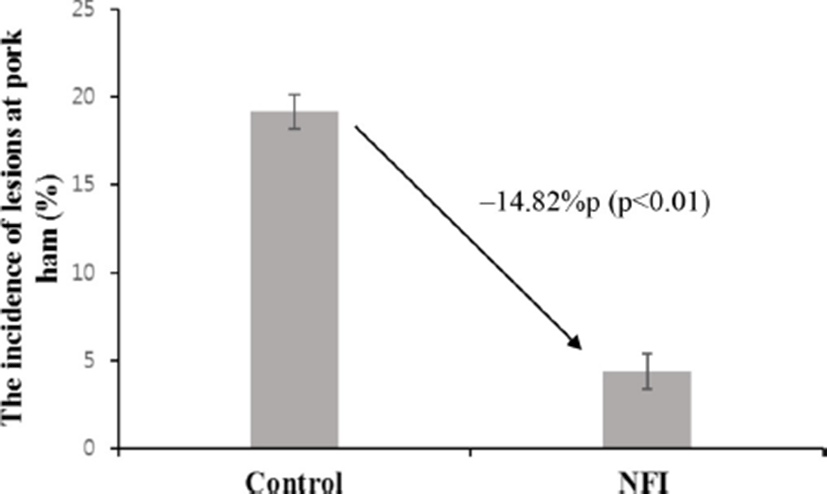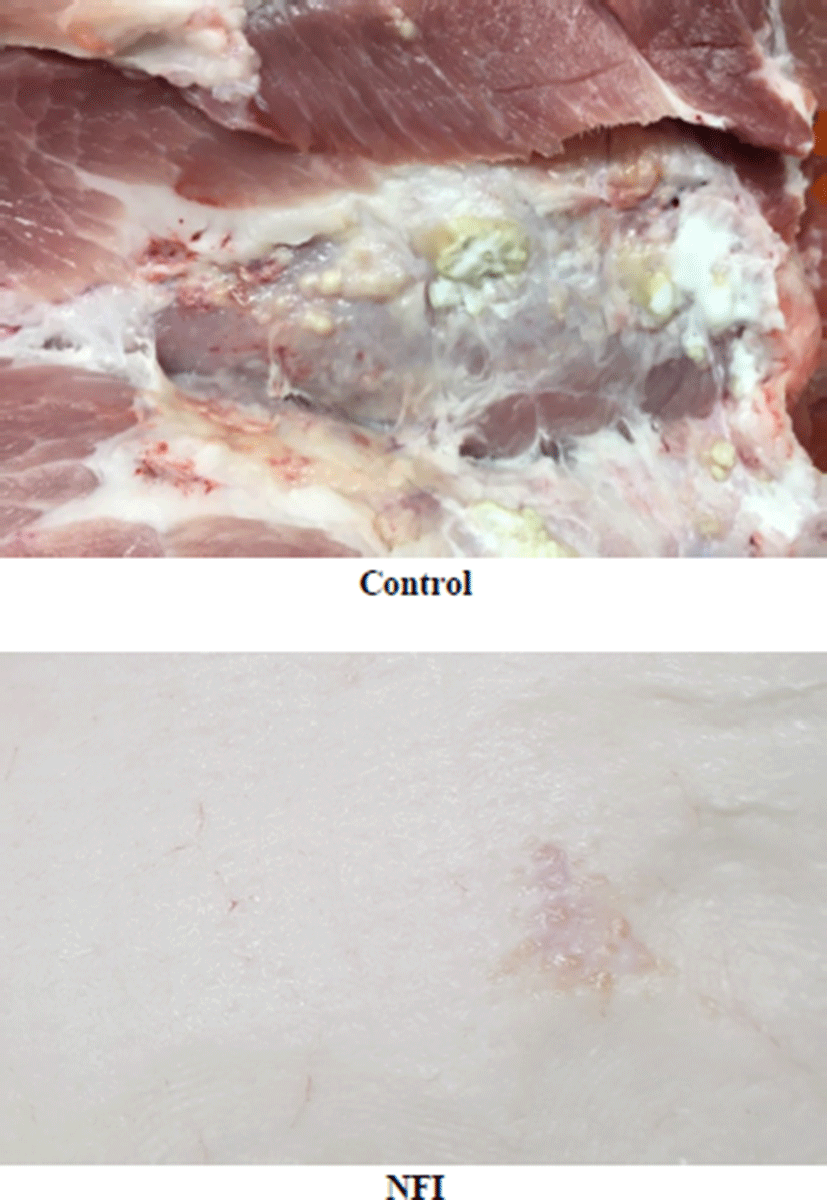Introduction
Foot-and-mouth disease (FMD) is an infectious disease affecting pigs and other cloven-hoofed animals, and its outbreak results in a vast economic loss. Therefore, the control of FMD is very important in swine husbandry and is achieved via FMD vaccination (Ko et al., 2018). The intensive vaccination campaigns for FMD were started in 2011 in Korea because a large outbreak of FMD became a problem across the nation in 2010.
The vaccination is generally delivered with an injection because that has higher absorptivity than oral inoculation (Li et al., 2011). However, the vaccine administered by a needle syringe results in adverse effects such as pain, stress, broken needle residue in the carcass, tissue damage, and incidence of lesions at the injection sites such as neck and ham (Chase et al., 2008). A previous study found lesions such as granuloma, abscess, and fibrosis at the vaccination site in animal carcasses (Ferreira et al., 2016; Yeruham et al., 2001). In addition, Ko et al. (2018) reported that the incidence of lesions in pork butt severely increased after FMD vaccination. The incidence of lesions in pork results in an economic loss in swine husbandry because the lesioned areas are discarded, and the surrounding areas are trimmed.
The tissue damage and bacterial contamination caused by syringe needles are a reason for the incidence of lesions in the injection site (Chase et al., 2008; Li et al., 2011). Therefore, needle-free injection (NFI) has been recommended in swine husbandry. NFI has many advantages compared to conventional injection methods using a syringe needle. It requires a low volume of vaccine and results in less pain, less stress, and no risk of residual needles in the pork carcass (Mitragotri, 2006; Sarno et al., 2000). In NFI, the vaccine penetrates the tissue by mechanical compression generated by a spring, battery, or gas in NFI (Chase et al., 2008). NFI is divided into two categories depending on the penetration depth of the vaccine with different compression force. NFI with a high compression force results in the penetration of the vaccine into the muscle tissue (intramuscular NFI). The vaccine can be deposited under the subcutaneous tissue by reducing the compression force (transdermal NFI). Previous studies have suggested that NFI of vaccines could reduce the incidence of lesions at the vaccination site of animals (Chase et al., 2008; Li et al., 2011). However, Ko et al. (2018) found no effect of intramuscular NFI on the incidence of lesions at the site of FMD vaccination.
Therefore, we investigated the effect of transdermal NFI of the FMD vaccine on lesion incidence at the injection site of pigs compared to conventional injection using a syringe needle.
Materials and Methods
A total of 983 growing pigs were raised in a farm (Hamyang-Gun, Korea) and were cared for in accordance with the guidelines of Dodram Pig Farmers’ Cooperative. The piglets were vaccinated in the left ham twice at 56 d and 84 d of age with FMD O Compos (Aftogen Oleo®, Biogenesis Bago Ltd., Argentina), which was emulsified with the adjuvant (Montanide ISA 50 V2 80%/V2 20%, water in oil). Pigs (n=493) in the control group were vaccinated using a commercial syringe with 2 mL of vaccine. In the transdermal NFI group, 0.5 mL of the vaccine was injected into pigs (n=492) using a gas-powered jet injector (Pulse 50, Tri-on international Co., Ltd., Seoul, Korea) following the guidelines of the manufacturer. Pigs were slaughtered between March 2018 and August 2018 at six different times with consideration of the market weight in the Dodram livestock processing complex slaughterhouse (Gimje-si, Korea). Eighty-two or eighty-three pigs per treatment were slaughtered at each time, and each slaughter time was considered as a replication.
The pork carcasses were deboned in the Dodram livestock processing complex (Gimje-si, Korea). The incidence of lesions such as abscesses, fibrosis, and granulomata in the pork ham of all carcasses was inspected by plant workers. The number of pork carcasses that had lesions in the pork ham was recorded.
This study examined the effect of transdermal NFI of the FMD vaccine on the incidence of lesions at pork ham by estimating the following linear model.
where Yi is the incidence of lesions, Xi is NFI treatment, Zi is the number of pigs, and ei is the usual error term for the observation i, ei~N(0,σ2). The number of pigs is included in the model to consider the potential effect of the difference in the number of pigs on the incidence of lesions. The models were estimated using Stata 14 software (StataCorp., 2015).
Results and Discussion
The adjusted coefficient of determination is 0.9543, which implies that the estimated regression explains the relationship between independent variables and dependent variable very well. The estimation result showed that transdermal NFI of the FMD vaccine into pigs had a statistically significant effect on the incidence of lesions in the pork ham (i.e., the vaccination site) at p<0.01. The incidence of lesions in the pork ham from pigs vaccinated by transdermal NFI was 4.35% while that from control was 19.17% (Fig. 1). The use of transdermal NFI reduced the incidence of lesions by 14.82% compared to conventional injection with syringe needle. On the other hand, the effect of the number of pigs tested in this study on the incidence of lesions in pork ham was relatively small and not statistically significant. Since we used an ordinary least square method to estimate the linear model, variance inflation factors (VIF) for independent variables and the Breusch-Pagan test were conducted to detect multicollinearity and heteroscedasticity. The VIF for both treatments and number of pigs tested was 1.02 and the result of the Breusch-Pagan test was that p>χ2=0.5850. Therefore, neither multicollinearity nor heteroscedasticity was detected.

The incidence of lesions in the pork meat at the injection sites associated with the injection of various vaccines, including the FMD vaccine, has been reported (Houser et al., 2004; Ko et al., 2018; Vatulini et al., 2005). It is known that the tissue damage and contamination caused by a syringe needle and vaccine adjuvant are major factors in generating lesions (Li et al., 2011; Reurink et al., 2014). A previous study found that the intramuscular NFI of the FMD vaccine into pigs generated similar lesions to the injection of the FMD vaccine using a syringe needle at a pork butt injection site (Ko et al., 2018). However, the transdermal NFI of the FMD vaccine decreased the incidence of lesions in the pork ham effectively in the present study. The different effects between intramuscular NFI and transdermal NFI on the lesion incidence at the injection site of vaccines may be related with the deposited positions of vaccines. The intramuscular NFI of vaccines deposits vaccines in muscles that could generate lesions by the residue of vaccine adjuvant in muscle (Chase et al., 2008; Vatulini et al., 2005). However, the transdermal NFI of vaccines deposited vaccines between subcutaneous tissue and underlying shallow muscle. Therefore, the transdermal NFI of vaccines might not damage muscle tissue (Chase et al., 2008). The lesions in the pork ham were generated as in Fig. 2 when the FMD vaccine was injected using a syringe needle in the present study, which led to a five-dollar per affected pig deduction from a farm (data not shown). However, pigs that were vaccinated using transdermal NFI did not lead to a deduction because no lesions were found in the muscle of the pork ham. Although lesions were also generated in the pork ham of pigs vaccinated using transdermal NFI, the faint lesions were found only in subcutaneous tissue (Fig. 2).

The NFI of vaccines is known to enhance immune response because of the larger dispersion of vaccines compared with vaccination using a syringe needle which increases the reaction antigen-presenting cells to the antigen (Jackson et al., 2001). In addition, the transdermal NFI of vaccines is more effective in enhancing the immune response because the more antibodies are generated when the antigen is delivered to the dermal and subcutaneous tissues because those tissues have more antigen-presenting cells than muscle (Itano et al., 2003; Mitragotri, 2005).
The use of the NFI device in swine husbandry requires an additional cost for purchasing and maintaining the device. Nevertheless, the decrease in abnormal meat production caused by a reduced incidence of lesions in pork meat can be economical in the long term. In addition, needle-stick injuries in swine workers can be prevented with the use of the NFI device.













